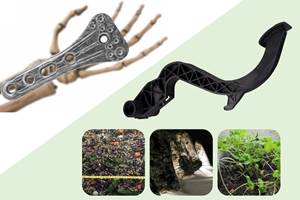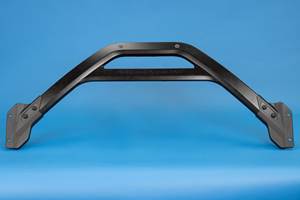Q&A: Manish Patel and Ashley Graeber of Web Industries
CW Talks: The Composites Podcast speaks with Manish Patel, senior application engineer, and Ashley Graeber, director of sales and business development, about Web Industries’ place in the composites supply chain.
Editor’s note: CW Talks: The Composites Podcast, recently spoke with Patel, senior application engineer, and Graeber, director of sales and business development, about Web Industries (Marlborough, MA, US) and its place in the composites supply chain as a slitter of carbon and glass fiber tapes into smaller tows, and as a provider of cutting and kitting services. Patel explores the company’s technical expertise, while Graeber reviews the company’s commercial presence. What follows is excerpted from the podcast. To hear the complete interview, check out CW Talks on iTunes or Google Play, or at CompositesWorld.com/podcast.
CW: Let’s talk about Web Industries itself. Where does it fit into composites manufacturing and into the composites supply chain?
AG: Interesting question. We’ve played a valuable role in the industry, but outside our immediate customer base, which is fairly narrow, we are not that well known. We spent the last 20-plus years pioneering our product development and working with formatting solutions, mostly with a small group of customers. We’re working actively to broaden our market awareness and perception, with expansion of our facilities and services globally.
CW: The core of Web’s business, its legacy, is slitting of prepregs for automated fiber and tape placement. What are the challenges associated with slitting?
MP: First, we love challenges, it’s true. It’s not just about slitting and spooling up on the core. Each carbon fiber and resin mix behaves and processes differently, with a different temperature and humidity needed when we are processing. I would say our biggest challenge concerns projects that use a hand layup product and transitioning that product to automated fiber placement layup.… Hand layup products tend to be overly tacky, and are not optimized for AFP processing.
AG: To add to what to Manish said, the commercial challenge is just that: We just slit fabric, and how hard can it possibly be …. I’ve actually heard that quite a few times. But as Manish said, most manufacturers don’t understand the value impact that precision-slit, custom-spooled tape can have on their manufacturing process. In the early stages, it can reduce time to market, and during the production life cycle, it’s all about ongoing increased equipment uptime and production throughput.
CW: As the two of you look to the future of aerospace composites, what opportunities do you see from a technical and from a commercial perspective?
MP: Currently we’re heavily involved with thermoplastics processing. This is not a new product, but it’s going to play a significant role in the future. We believe the market will see more material types being used on future aircraft as engineers optimize the parts based on the material itself … regardless of the material type and processing method…we want to provide a solution path to make parts in the most efficient way.
AG: From a commercial perspective, I’m excited about the prospects, for both Web and the aerocomposites industry, so definitely a bright future … we’ve opened a thermoplastics center of excellence and are working diligently with our key customers on some various formatting disciplines specific to thermoplastics.
CW: As you look over this industry and as you look back on your experience, what is your assessment of the future of the composites industry?
AG: Our worries are the same as any industry that’s healthy, and that’s that we have huge production volumes, growth in production volumes, which bring price pressures, supply chain challenges. You mentioned thermoplastics — there’s the availability of material to drive that industry, and also the standard competitive pressures … just looking at the different design options that composites allow, and the growing adoption of composites across all those industry segments … it’s really hard not to be excited.
MP: From the technical side, the dynamic nature of the business is not new. During our 50 years’ history in the formatting business, we have seen many changes. We fully expect that the composites industry will continue to evolve and mature with the changes that we don’t fully see today …. We fully expect that in 10 to 15 years our service model for this market will look very different than what it is today.Related Content
Owens Corning initiates review of strategic alternatives for glass fiber business
Owens Corning considers alternative options like a potential sale or spin-off as part of its transformative move to strengthen its position in building and construction materials.
Read MoreBioabsorbable and degradable glass fibers, compostable composite parts
ABM Composite offers sustainable options and up to a 60% reduction in carbon footprint for glass fiber-reinforced composites.
Read MoreUnderstanding vacuum bagging layers in production, repair
Recognizing the functions of each layer in a vacuum bag schedule can help users discover what vacuum bag schedules work best for their application.
Read MoreAutomotive chassis components lighten up with composites
Composite and hybrid components reduce mass, increase functionality on electric and conventional passenger vehicles.
Read MoreRead Next
“Structured air” TPS safeguards composite structures
Powered by an 85% air/15% pure polyimide aerogel, Blueshift’s novel material system protects structures during transient thermal events from -200°C to beyond 2400°C for rockets, battery boxes and more.
Read MoreVIDEO: High-volume processing for fiberglass components
Cannon Ergos, a company specializing in high-ton presses and equipment for composites fabrication and plastics processing, displayed automotive and industrial components at CAMX 2024.
Read MorePlant tour: Daher Shap’in TechCenter and composites production plant, Saint-Aignan-de-Grandlieu, France
Co-located R&D and production advance OOA thermosets, thermoplastics, welding, recycling and digital technologies for faster processing and certification of lighter, more sustainable composites.
Read More




















